Artificial Intelligence
We take a look at just why most robots on Red Dwarf have the same IQ as an especially dumb glass of water.
11 October, 2002
Vending machines that argue back, nanobots who rebuild things at ten times their original size, toasters obsessed to the point of psychosis with the need to heat bread. When it comes to Red Dwarf's electronic life forms, the term 'artificial intelligence' sometimes seems rather generous.
There are essentially four kinds of mechanical intelligence encountered over the eight series of Red Dwarf. Full on 'ships' computers', robots (including androids and simulants), low-grade AI machines (toasters, toilets, escort boots) and finally 'composites'. What are composites? You'll just have to read on. And no skipping ahead.
COMPUTERS
Most vessels in Red Dwarf's future have a computer in place to navigate the ship through space - though, luckily for Kochanski's career, they don't seem to have completely replaced Navigation officers. Holly, Red Dwarf's own on-board computer, appears like most of his counterparts as a head floating in a black void. He can appear on any monitor on the ship as well as on watch faces, and in some circumstances has a 'body' in the shape of a monitor on wheels.
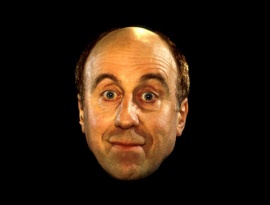
But Holly is computer senile. Maybe it was the loneliness of space that did it, maybe it was when he lost his friendship with his collection of singing potatoes. Whatever the reason, Holly has, by now, pretty much lost the plot - to the point that a head sex change operation seemed to be a really good idea.
Clearly, the creators of AI have included some of man's flaws. The ability to go completely do-lally, for instance. It's a trait Holly seems to share with the equally baffled Gordon, the ship's computer on the Scott Fitzgerald. (To quote from their postal chess game: "Pawn, right? That's the little knobbly ones down the front..."). Ace Rimmer's on-board computer has a tendency to fall in love at inconvenient moments. The female Holly, too, managed to pass out from Ace's charms. What a guy.
Other computers fare little better. The booming, 'voice-of-God' type machines running Justice World, the DNA Modifier and the Enforcement Orb seem to wield ultimate power, but don't seem to be that 'intelligent'. The Orb and Justice computer exist in a black and white world of right and wrong. A lengthy trial is required to prove the difference between 'guilt' and culpability. Rimmer may be responsible for the deaths of 1,167 members of the crew - 1,168 if you count himself - but he didn't murder them.
The DNA modifier only responds to commands - a huge problem when those commands are coming from either Cat pushing pretty coloured buttons, or an interface with the dim-witted Holly. The computer is, in this case, only as capable as its operator - which, as anyone who's wrestled with their PC will tell you, really isn't much help. And it certainly ain't artificial intelligence.
A similar logic machine exists on the holoship Enlightenment. It has stochastic capabilities, hence the nickname 'Stocky'. But, cute name or no, it has no intellect of its own. Maybe the IQ-proud holo-crew didn't want to be outdone. Even Red Dwarf's self destruct computer is blissfully unaware that, at the end of its countdown, there is no longer a bomb aboard to blow up.
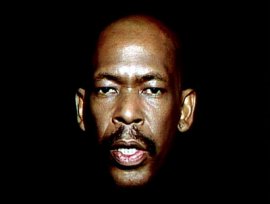
When his intellect is questioned, Holly creates an alter-ego. The crew, complaining that Holly is 'out to lunch', seem to want a less quirky machine in charge. What they get is the uncompromising face of Queeg 500. Queeg doesn't bend rules, he follows directives to the letter - in that way, he has more in common with the Justice computer. Inevitably, the crew come to realise that the odd quirk is no bad thing.
In the middle of this, we have Cassandra, the computer created with the ability to predict the future. Initially it seems that her ability is linked with a directness and honesty - when she speaks, it's always to make another prediction. But the clues are there. Cassandra revels in her ability, she takes pleasure in being right - and this should have given the Dwarfers a moments of pause.
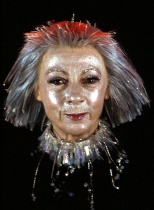
Cassandra, it turns out, is a lot more than she seems. Some of her predictions are lies, designed to hurt Lister who, she knows, is destined to destroy her. While at first glance Cassandra seems to be functioning just on a set of commands, the truth is that she has a mind, and an agenda, of her own. She is intelligent. Though not smart enough to realise that she could have predicted her own plan going wrong.
MACHINES
Sometimes a little intelligence is worse than none at all. You can't imagine the Justice computer having an in-depth conversation about the need for regular trials, or Queeg arranging seminars on the necessity for order and discipline. But Talkie Toaster? Well, it's hard to shut the little git up.
Talkie has enough of an intellect to consider his life in philosophical terms: "I toast, therefore I am." While he does sometimes wonder if there might be more to life than heating bread, his reason for being is wrapped up in getting others to consume toast. (It's interesting to note that he doesn't just want to make it, it has to be eaten, too. Otherwise the crew could just leave the dozy appliance to it.)
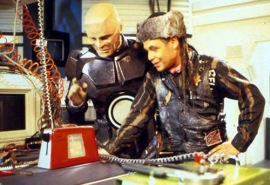
It's not hard to imagine that Petersen's Smart Shoes - mentioned by Lister in Queeg - had similar motivations. If Lister's anecdote is to be believed, the shoes got bored of just walking to and from the pub; they wanted to see the world. The shoes had ambition, and no doubt saw walking as the most important role one could have. They walk, therefore they are.
Justice World's escort boots, which seem to do a similar job, could very well be Smart Shoes without the intellect. Like the main computer, they follow simple directives and never falter - indeed, they are under the Justice computer's control. Just as well - left to their own devices, they might take the walker on a quick trip to an airlock. And the skutters? By day, service droids for the Space Corps; by night, John Wayne fans. These are droids with their own tastes.
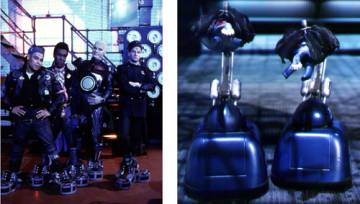
Kryten's nanobots, meanwhile, suffer the same problem as the Shoes and the Toaster - they got bored. With just enough artificial intellect to realise that there's more to the universe than simply performing repairs on their host's body, they escaped. As far as Red Dwarf, anyway. While questing for something unimaginably 'more', they ended up still rebuilding things, just on a grander scale.
Oh, and do spare a thought for Lister's robot goldfish. Most likely, these creatures are programmed with a three-second memory - during which period they no doubt contemplate how vital it is to the world that they continue to swim in small but erratic circles.
Finally, we have the waxdroids. Again, pre-programmed to simply repeat pre-defined actions, they have evolved, broken their programming and now do whatever they want... sort of. After all, the Elvis waxdroid still acts like Elvis. Pythagoras remains obsessed with triangles, and Marilyn Monroe can't help but talk in that sexy, breathy voice.
ROBOTS
The key difference between an android and a simulant, we are told, is that an android would never rip off a human's head and spit down his neck. Of course, this rather implies that the two species are, otherwise, pretty similar...
When Professor Mamet created the 4000 Series mechanoid, it was the latest in a long line. The Series 3000 had been designed - like all mechanoids - to serve humans, but was also built to look like them. When that proved unnerving, the line was scrapped and the new generation built with heads shaped like novelty condoms.
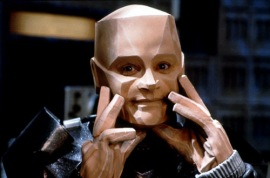
Mechanoids are at once a servant and a cultural accessory. The 4000 GTI model comes with realistic toes and a slide-back sun-roof head. They also, importantly, come with a nega-drive, a device which stores all their resentment and negativity. So: mechanoids have emotions.
It's a complex relationship. Kryten clearly has opinions, and during his time with Lister has developed ways of articulating his feelings as opposed to keeping them all in (stored, of course, on the nega-drive). He's also learned to lie... albeit not always convincingly. His guilt chip is an AI way of creating yet more feeling, in this case designed to prevent him transgressing his own moral code - which means Kryten and his ilk also have morals, even if it's just part of the programming.
Compared to the psychotic killing machine simulants, mechanoids seem very different. But, ultimately, they share more in common than many realise. Both constructed by humans to serve their ends - war in the case of simulants, blocked toilets for the mechs - the key difference is guilt. The simulants have none. Why build a fighting machine only to have it break off mid-conflict to write an epic poem on the horrors of war?
Over time, simulants learned to break their programming, just as mechanoids did. But while mechs continued to feel guilt, and therefore remain mostly passive, sims have turned on their former masters. And, you have to say, who can blame them? When the 3000 series was discontinued, many mechanoids reprogrammed themselves to believe they were human, hoping to avoid detection - if they hadn't, humans would have destroyed them.
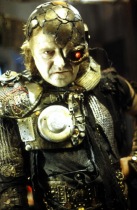
Simulants indulge their desires and lusts (mostly for killing, but stealing comes a close second), but in their way mechanoids do the same. Kryten loves nothing better than a good ironing session, and Able (Kryten's long lost 'brother') is fatally addicted to Outrozone. Who'd supply a mechanoid 'drug' if there were no demand, if the droids didn't desire it?
The artificial intelligence in mechanoids and simulants seems to be as advanced as it can be. Personalities come from a combination of self-determination and programming. Judgements come from experience, emotion and opinion. (The Inquisitor has, after living until the end of time itself, concluded that a life is defined by its 'worth' and actually does his psychotic best to make humanity the best it can be.)
But there's one more form of AI in Red Dwarf - the most advanced there is.
COMPOSITES
What can replicate genuine intelligence better than an exact re-creation of a human being? In a future where a person's thoughts, memories, feelings and opinions can be stored on a computer disc, the most impressive artificial intelligence is the hologram.
Arnold Rimmer (and I apologise for the use of Rimmer as an example of 'intelligence') is dead. But here he is walking around, making decisions, having reactions - mostly in the form of running away and hiding, but still. This is not Rimmer. The hologram Rimmer is a simulation, he is not the actual person. But the computer continually assesses his environment and provides the reaction Rimmer would have made.

The reconstruction of a human life, since the invention of the hard-light drive, has become almost perfect - to the point where holograms question their sense of being with criteria humans would never have to consider. It really is evidence of a self-aware intelligence that Rimmer resents being dead; when appearing in soft-light, he finds the inability to touch a frustration. Holograms also live 'forever', if Rimmer's centuries on Rimmerworld are anything to go by, and yet they can be programmed to age, too, as his future self proves in Out of Time.
So where next for AI in Red Dwarf? Perhaps the future is in the amalgamation of genuine minds. In a general way, the holoship combines hundreds of genius minds in one mass simulation - but there is further to go. Mind patching allows several intelligences, and an amalgam of their personalities, to inhabit one overall mind.
Perhaps it was the illegal and dangerous mind-patching experiments that led twenty-third century scientists Heidegger, Davro, Holder, Quayle to create 'gestalt' entity Legion, a being comprised of the conscious minds of those within his mental reach.
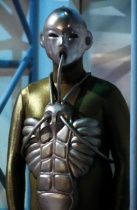
In this form, Legion had access to a combined intelligence - but one that is rendered nevertheless interpretive, translated, artificial. But he doesn't just take hold of facts, he also compiles the fear and anger. This makes him capable of insane rage, and devious psychosis.
So - not so very different from the toaster after all.














